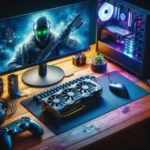In an age where immersive gaming experiences are paramount, the roar of fans and the hum of hardware can often detract from the thrill of your virtual adventures.
For many gamers, the quest for a whisper-quiet setup is as important as achieving high frame rates and stunning graphics. Building a silent gaming PC isn’t just about reducing noise; it’s about creating an environment where you can fully immerse yourself in your favorite worlds without distractions. In this ultimate guide, we’ll explore everything you need to know about assembling a near-silent gaming rig—from selecting the right components and utilizing sound-dampening materials to implementing effective cooling solutions. Whether you’re a seasoned builder or a newcomer to the gaming scene, get ready to transform your gaming space into a serene sanctuary that lets your gameplay shine through, all while keeping the noise to a bare minimum.
1. Understanding the Importance of a Silent Gaming PC
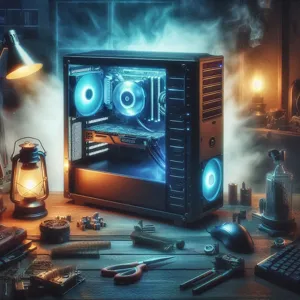
When it comes to the ultimate gaming experience, the roar of high-performance hardware can often drown out the immersive soundscapes of your favorite games. Understanding the importance of a silent gaming PC goes beyond just reducing noise; it’s about enhancing your gaming environment, improving focus, and creating a more enjoyable atmosphere.
In an age where gaming has evolved into a multisensory event, the auditory landscape plays a critical role. A silent PC allows you to fully appreciate the intricate details of sound design—every footstep, whisper, and explosion—without the distraction of grinding fans or vibrating components. Imagine diving into a visually stunning open-world game, only to be jolted out of the experience by the relentless hum of your system. By prioritizing silence, you can maintain that immersive bubble, allowing the game’s narrative and atmosphere to envelop you completely.
Moreover, a quiet gaming PC contributes to a more serene living or working space. Whether you’re gaming into the early hours or livestreaming your sessions, a peaceful environment is essential for both your enjoyment and your audience’s experience. The absence of disruptive noise can even lead to better concentration and longer gaming sessions without fatigue.
Additionally, the quest for silence often leads to the adoption of high-quality components and thoughtful design choices. This means investing in efficient cooling solutions, noise-dampening cases, and premium fans that operate at whisper-quiet levels. As you embark on building your silent gaming PC, you’ll find that this focus on quiet operation often results in improved performance and longevity, as components run cooler and with less strain.
In essence, understanding the importance of a silent gaming PC is about crafting an unparalleled gaming experience—one where every sound is intentional, every moment is immersive, and every session is enjoyable. By embracing silence, you not only enhance your gameplay but redefine what it means to be a gamer in a world where noise often reigns supreme.
2. Key Components for a Whisper-Quiet Build
When embarking on your journey to create a whisper-quiet gaming PC, selecting the right components is crucial. The heart of any gaming rig lies in its components, and for a silent build, you’ll want to prioritize those that are engineered for minimal noise output without sacrificing performance.
1. **Processor (CPU)**: Begin with a CPU that offers excellent performance while generating less heat. Look for models with lower thermal design power (TDP) ratings, as they tend to run cooler and quieter. Pair your CPU with a high-quality cooler designed for silent operation. Brands like Noctua or be quiet! manufacture coolers that excel in noise reduction, ensuring that your gaming sessions remain serene.
2. **Graphics Card (GPU)**: The GPU is often the noisiest component in a gaming PC, especially under heavy load. Opt for models with advanced cooling solutions that include larger fans and vapor chamber technology, which can dissipate heat efficiently at lower RPMs. Check reviews for noise levels during gaming to find cards that balance power and quiet performance.
3. **Power Supply Unit (PSU)**: A power supply can contribute significantly to system noise, so choose one that features a fanless operation or a semi-fanless mode that allows the fan to remain off under lower loads. Look for high-efficiency ratings (80 Plus Gold or Platinum) to ensure minimal energy waste and heat generation.
4. **Case Selection**: The right case can make all the difference. Opt for an enclosure designed specifically for noise reduction, featuring sound-dampening materials and a layout that promotes efficient airflow without the need for excessive fan speeds. Cases from brands like Fractal Design and Corsair often come with noise-reducing features that keep the cacophony at bay.
5. **Storage Solutions**: Traditional hard drives can be a source of noise, so consider solid-state drives (SSDs) instead. Not only do they perform faster, but they also operate silently since they have no moving parts. If you need larger storage capacities, look for hybrid solutions or silent hard drives that are designed for low noise output.
By carefully selecting these key components, you can build a gaming PC that not only meets your performance needs but also creates a peaceful gaming environment. With the right choices, you’ll find that immersive gameplay doesn’t have to be accompanied by the roar of fans and components, allowing you to focus fully on the adventure ahead.
3. Choosing the Right Case: Soundproofing Features
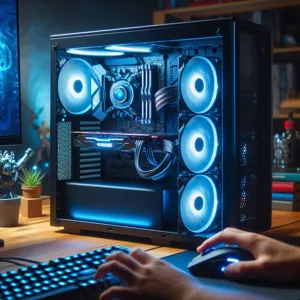
When it comes to building a whisper-quiet gaming PC, the choice of case is critical. Not all cases are created equal, and selecting one with soundproofing features can significantly dampen the noise generated by your components. Look for cases that come with sound-absorbing materials, often found in the form of foam lining on the interior or panels specifically designed to minimize vibrations.
Consider cases with thick, tempered glass or solid side panels, as these tend to provide better sound insulation compared to those with perforated designs. Additionally, some models come equipped with noise-dampening rubber mounts for hard drives and fans, which can further reduce the hum of mechanical parts in action.
Ventilation is another aspect to consider. While you want a case that keeps your components cool, too many openings can let sound escape. Look for cases that balance airflow with noise reduction, featuring strategically placed vents that allow for efficient cooling without compromising your quest for silence.
Finally, pay attention to the size and layout of the case. A larger case can house more fans and cooling solutions, allowing you to run them at lower speeds, which translates to quieter operation. Ultimately, investing in a well-designed case with soundproofing features will lay the foundation for your silent gaming experience, ensuring that the only sounds you hear during gameplay are the immersive audio of the game itself, rather than the clamor of your hardware.
4. Selecting Low-Noise Fans and Cooling Solutions
When it comes to assembling a whisper-quiet gaming PC, one of the most crucial elements to consider is your choice of fans and cooling solutions. Traditional cooling methods often produce unwanted noise, but with the right approach, you can create an environment that allows for immersive gaming without the distraction of whirring, buzzing, or rattling.
First and foremost, look for fans specifically designed for low noise operation. These fans typically feature advanced blade designs and high-quality bearings that minimize turbulence and vibration, significantly reducing sound levels. Brands like Noctua and Be Quiet! are renowned for their silent cooling products, offering fans that provide excellent airflow while maintaining a near-silent performance. Opting for larger fans can also be advantageous; they can move the same amount of air at lower RPMs compared to smaller counterparts, thereby decreasing noise output.
In addition to fans, consider your overall cooling solution. Liquid cooling systems, particularly those with larger radiators and quieter pumps, can be an excellent choice for a silent build. A closed-loop liquid cooler with a low-noise pump can keep your CPU temperatures in check without the incessant hum of traditional air cooling systems. Plus, many liquid coolers come with customizable RGB lighting, allowing you to enhance your build’s aesthetics while keeping noise at bay.
Don’t forget to prioritize the positioning and airflow within your case. Proper cable management and strategic fan placement can reduce noise levels by creating a more efficient airflow path. Consider using sound-dampening materials within your case, such as acoustic foam or rubber grommets, to further absorb sound.
By selecting low-noise fans and implementing effective cooling solutions, you can significantly enhance your gaming experience. With a silent setup, each sound becomes more pronounced, immersing you deeper into the worlds you explore. Enjoy your favorite games without the distracting drone of an overactive cooling system, and revel in the serenity of a whisper-quiet gaming environment.
5. The Role of a Silent Power Supply Unit (PSU)
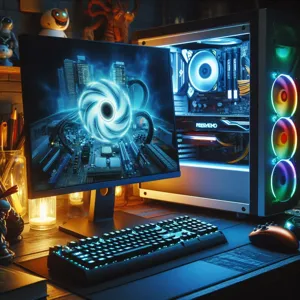
When it comes to building a whisper-quiet gaming PC, the power supply unit (PSU) plays a pivotal role that often goes unnoticed. While many enthusiasts focus on the CPU, GPU, and cooling solutions, the PSU is a crucial component that can significantly affect your system’s noise levels. A silent PSU not only ensures steady power delivery to your components but also operates quietly, allowing you to immerse yourself fully in your gaming experience without the distracting hum of a loud fan.
Modern silent PSUs are designed with advanced technologies that minimize noise output. These units often feature larger, more efficient fans that can run at lower RPMs during typical gaming loads. Some even employ fanless designs for lower wattages, relying on passive cooling to maintain optimal temperatures without generating any sound. When selecting a PSU, look for models labeled as “80 Plus” certified; these units not only provide energy efficiency but also tend to produce less heat, meaning that their fans don’t need to work as hard—resulting in quieter operation.
Moreover, consider the PSU’s design and build quality. Units with high-quality capacitors and robust internal components are likely to operate more efficiently and quietly. Some brands have also implemented technologies such as hybrid fan modes, where the fan only kicks in under heavy loads, ensuring silent performance during light gaming or everyday tasks.
In essence, investing in a silent power supply unit is a crucial step in your quest for a serene gaming environment. By prioritizing a unit with low noise characteristics, you’ll enhance not just the tranquility of your setup but also the longevity and reliability of your entire system. Remember, a powerful gaming rig doesn’t have to come with a cacophony of noise; with the right PSU, you can enjoy your games in peaceful solitude.
6. Opting for a Quiet Graphics Card: What to Look For
When it comes to building a whisper-quiet gaming PC, the graphics card plays a pivotal role—not just in performance but also in noise levels. A powerful GPU can enhance your gaming experience, but if it sounds like a jet engine taking off, it can quickly ruin the immersion. Here are some key factors to consider when selecting a quiet graphics card that meets your gaming needs without causing a ruckus.
**Cooling Solutions**: The type of cooling solution used on the graphics card significantly affects its noise output. Look for models equipped with advanced cooling technologies, such as dual or triple fans with larger diameters, which can move more air at lower RPMs. Some cards even feature passive cooling modes, allowing them to operate silently during low-intensity tasks. Cards with liquid cooling systems are also worth considering, as they tend to generate minimal noise while efficiently dissipating heat.
**Fan Design and Quality**: Pay attention to the fan design as well. Look for graphics cards that utilize high-quality, low-noise fans. Some manufacturers offer specialized fan blades designed to optimize airflow while minimizing turbulence, resulting in quieter operation. Features like fan stop technology—where the fans only activate under load—can also help keep noise levels down during light usage.
**Build Quality**: A well-constructed graphics card with robust components can contribute to a quieter operation. Cards featuring metal backplates and reinforced frames often experience less vibration, meaning less noise. Additionally, check for customer reviews that highlight noise levels under load. Real-world feedback can provide insight into how a card performs in everyday gaming scenarios.
**Performance vs. Noise Balance**: While it’s essential to find a quiet graphics card, don’t sacrifice performance for silence. Look for a balance that meets your gaming requirements while still adhering to your noise preferences. Mid-range cards often provide excellent performance without the excessive noise levels found in some high-end models designed for extreme gaming.
In summary, opting for a quiet graphics card involves considering cooling solutions, fan design, build quality, and the performance-noise trade-off. By taking the time to research and select the right GPU, you can create a gaming setup that delivers thrilling visuals and gameplay—all while maintaining a serene and immersive environment. With the right choices, you can enjoy your favorite titles without the distracting hum of an overworked graphics card.
7. Solid-State Drives (SSDs) vs. Traditional Hard Drives (HDDs)
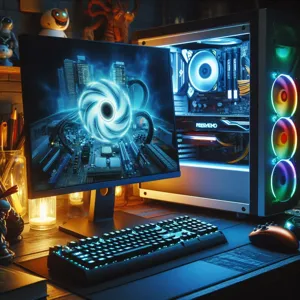
When it comes to building a whisper-quiet gaming PC, one of the most significant decisions you’ll face is choosing between Solid-State Drives (SSDs) and Traditional Hard Drives (HDDs). This choice not only affects your system’s performance but also its noise output, which is crucial for a serene gaming environment.
SSDs, with their sleek and modern design, stand out for their remarkable speed and efficiency. Unlike HDDs, which rely on spinning disks and moving read/write heads, SSDs utilize flash memory to store data. This fundamental difference means that SSDs operate silently, producing virtually no noise during use. Imagine diving into your favorite immersive game, with crisp graphics and responsive load times, all while enjoying the tranquility of your environment. With an SSD, you can achieve that blissful state, as it minimizes distractions and allows you to fully engage in your gaming sessions.
On the other hand, traditional HDDs, while often more affordable and offering larger storage capacities, come with mechanical components that can generate audible sounds. The whirring of spinning platters and the clicking of read/write arms can disrupt the gaming experience, creating an unwelcome backdrop of noise that detracts from the immersion. For gamers who value a quiet atmosphere, the clattering of an HDD can be a dealbreaker.
While SSDs may initially come with a higher price tag for similar storage capacities, the benefits extend beyond just silence. They boast faster boot times, quicker game load times, and improved system responsiveness, all of which contribute to a smoother gaming experience. Many gamers find that the investment in an SSD is well worth it, particularly when paired with a silent cooling system and other noise-reducing components.
For those who require ample storage and are considering an HDD, it’s worth exploring hybrid solutions. A setup combining an SSD for your operating system and frequently played games, alongside an HDD for bulk storage, can strike the perfect balance between speed and capacity while still keeping noise levels manageable.
Ultimately, your choice between SSDs and HDDs will depend on your specific gaming needs, budget, and desire for a quiet gaming environment. However, if silence is golden in your gaming setup, opting for an SSD is a step in the right direction towards achieving the ultimate whisper-quiet gaming experience.
8. Acoustic Dampening Materials: Where to Use Them
When it comes to building a whisper-quiet gaming PC, the strategic use of acoustic dampening materials can make all the difference in creating a serene gaming environment. These materials are designed to absorb sound and minimize vibrations, effectively lowering the noise levels generated by your components. Here are some key areas where you can implement these materials to achieve optimal soundproofing.
**1. Inside the Case:** Begin with the interior of your PC case. Applying acoustic foam or sound-dampening panels inside the case helps to absorb noise emitted from your graphics card, power supply, and cooling fans. Look for high-density foam or specialized soundproofing mats that can be cut to fit your case’s dimensions. When placing these materials, cover the side panels, the bottom, and even the top if your case design allows it. This will create a quieter environment for your components to operate.
**2. Around Fans and Radiators:** Fans are notorious for generating noise, especially under load. Utilize rubber grommets or foam pads to mount your fans, which can help to reduce both vibration and sound transmission. If you’re using a liquid cooling solution, consider wrapping the radiator in acoustic material or placing it in a way that minimizes direct contact with the case to dampen the vibrations further.
**3. HDD and SSD Mounts:** Hard disk drives (HDDs) can produce significant noise during operation. Ensure that your HDDs are mounted using rubber or silicone mounts, which can effectively absorb vibrations. If you have the option, consider using solid-state drives (SSDs) instead, as they operate silently. However, if you do include HDDs, placing them in dedicated, sound-insulated compartments within your case can also help reduce noise.
**4. Power Supply Units (PSUs):** The PSU can be a major source of noise, especially under heavy load. Look for cases that feature sound-dampened power supply chambers or consider adding acoustic foam around the PSU area. Just be cautious of airflow; you want to ensure that the PSU remains adequately ventilated while minimizing sound.
**5. Cables and Accessories:** Lastly, don’t overlook the importance of managing your cables. Well-organized cables not only improve airflow but can also reduce noise caused by rattling or vibration. Use cable ties and velcro straps to secure and bundle cables neatly, minimizing movement and potential noise generation.
By strategically placing acoustic dampening materials in these key areas, you can significantly reduce the noise produced by your gaming PC. The result? A tranquil gaming experience that allows you to immerse yourself fully in your virtual worlds without the distraction of unwanted noise.
9. Cable Management Tips for Reduced Noise
Effective cable management is often overlooked in the quest for a silent gaming PC, yet it can play a pivotal role in reducing noise levels. When cables are allowed to roam free within your case, they can obstruct airflow, leading to increased fan speeds and, consequently, more noise. Here are some key tips to help you achieve a tidy and quiet setup:
**1. Invest in Quality Cables:** Start with high-quality, flexible cables that are easier to manage and route. Flat cables can save space and help in reducing clutter compared to traditional round cables. Consider using modular power supplies that allow you to use only the cables you need, minimizing excess.
**2. Use Cable Ties and Velcro Straps:** Once your cables are in place, secure them with cable ties or Velcro straps. Keeping cables bundled together not only improves aesthetics but also helps prevent them from interfering with fans and other components. A clean layout allows for better airflow, which can help keep your system cooler and quieter.
**3. Route Cables Behind the Motherboard Tray:** Many modern cases come with a dedicated space to route cables behind the motherboard tray. Take advantage of this feature to hide unsightly cables, creating a clean look while keeping them out of the airflow path.
**4. Keep Power Cables Away from Fans:** Make a conscious effort to route power cables away from fan blades and airflow zones. This minimizes the chances of cables vibrating against fans, which can generate unwanted noise.
**5. Utilize Cable Management holes:** Most cases are equipped with cable management holes designed to help you neatly route cables. Use these strategically to keep cables organized and out of sight.
**6. Regular Maintenance:** Lastly, don’t forget to periodically check your cable management. Dust and wear can cause cables to shift over time, leading to potential noise issues. A regular cleanup and reorganization can help maintain a silent setup.
By implementing these cable management strategies, you’ll not only enhance the overall aesthetics of your gaming rig but also contribute significantly to a quieter environment. A well-organized interior not only promotes optimal airflow but also helps your components operate efficiently, ultimately leading to a more enjoyable gaming experience.
10. BIOS Settings for Fan Control and Noise Reduction
When it comes to building a whisper-quiet gaming PC, one of the often-overlooked aspects is the BIOS settings, particularly those related to fan control and noise reduction. Your BIOS is the gateway to optimizing your system’s performance and acoustic footprint, allowing you to tailor how your fans operate based on temperature and workload.
First and foremost, access your BIOS by pressing the designated key—usually Del or F2—during the boot-up process. Once inside, look for the hardware monitoring section, which typically includes fan speed controls. Many modern motherboards come equipped with advanced fan curve options, allowing you to adjust the speed of your fans based on temperature thresholds. Setting a more gradual fan curve can significantly reduce noise levels, as the fans will only ramp up when necessary, rather than running at full speed all the time.
Another valuable feature to consider is the ‘Quiet Mode’ or ‘Silent Mode’ setting, which many BIOS interfaces offer. Enabling these modes will automatically adjust the fan speeds to maintain a quieter operation. If your motherboard supports it, consider using PWM (Pulse Width Modulation) fans, which provide finer control over fan speeds and result in quieter operation.
Additionally, pay attention to any power-saving settings within the BIOS. Enabling features like C-states can help lower the power consumption of your CPU when it’s not under heavy load, allowing for a quieter overall system operation.
Lastly, don’t forget to keep an eye on the temperatures of your components. A well-optimized cooling system is crucial; if your system is running too hot, fans will inevitably work harder, increasing noise levels. Regularly monitoring your temperatures and making adjustments to your cooling solutions can help you strike the perfect balance between thermal performance and acoustic tranquility.
By fine-tuning your BIOS settings for fan control and noise reduction, you can create a serene gaming environment where the only sounds you’ll hear are the immersive audio from your games, not the whir of your cooling system.
11. Software Solutions for Monitoring and Managing Noise Levels
When it comes to creating a whisper-quiet gaming PC, the hardware choices are just part of the equation; the software you use can significantly impact your noise levels as well. Leveraging the right software solutions allows you to monitor, manage, and optimize your system for silent operation, ensuring that you can immerse yourself in your gaming experience without being distracted by unnecessary noise.
**Temperature and Fan Control Software**
One of the primary contributors to noise in a gaming PC is the cooling system, particularly the fans. By using software like MSI Afterburner or FanControl, you can monitor your GPU and CPU temperatures in real time and adjust fan curves accordingly. With these tools, you can set your fans to ramp up only when temperatures exceed certain thresholds, allowing them to run at lower speeds—and therefore quieter—during regular gameplay. This not only reduces noise but can also extend the lifespan of your components by preventing overcooling.
**System Monitoring Tools**
Monitoring software, such as HWMonitor or Open Hardware Monitor, gives you insight into the various temperatures and performance metrics of your PC. By keeping an eye on the system’s performance, you can identify any components that are underperforming or running excessively hot, which may lead to noisier operation. If you notice certain parts are generating more heat, you can consider options like improving airflow in your case or adjusting your cooling solutions to maintain optimal performance with minimal noise.
**Noise-Canceling Software**
In addition to hardware and fan management, consider employing noise-canceling software for your gaming setup. Applications like Krisp or RTX Voice can filter out unwanted background sounds during gaming sessions or streaming, ensuring that your audio output remains clear and focused. This is especially beneficial if you’re using a microphone for in-game communication or streaming, as it can significantly enhance your audio quality without adding any extra noise from your environment.
**Game Mode Settings**
Many operating systems and gaming platforms offer “Game Mode” settings that prioritize system resources for your gaming applications. This not only enhances performance but can also help in minimizing the workload on your CPU and GPU, which translates to lower energy consumption and reduced fan noise. Enabling these settings can create a more tranquil gaming experience, letting you enjoy your favorite titles without the distraction of a noisy system.
By integrating these software solutions into your whisper-quiet gaming PC build, you can take control of your noise levels and tailor your system’s performance to suit your gaming needs. With the right combination of monitoring and management, you’ll create a serene environment that allows you to fully immerse yourself in the gameplay, without the unwanted hum of fans and components.
12. Building vs. Buying: Tailoring Your Silent Gaming Experience
When it comes to creating the ultimate whisper-quiet gaming rig, a pivotal decision lies in whether to build your own PC or buy a pre-assembled one. Each option has its merits, but understanding your specific needs and preferences is crucial to tailoring a silent gaming experience that truly resonates with you.
Building your own gaming PC offers unparalleled customization. You have the freedom to select each component, from the CPU and GPU to the cooling system, ensuring that every part is optimized for silence. Consider investing in high-quality, low-noise fans, such as fluid dynamic or magnetic levitation models, which can significantly reduce operational sound. Additionally, selecting components that are known for their quiet performance—like certain models of graphics cards and power supplies—can help you achieve that elusive silent gaming experience.
Moreover, building your PC allows you to integrate noise-dampening materials into your case. Acoustic foam, rubber grommets, and soundproof panels can be added to minimize vibrations and noise. This level of control means you can design a system that not only performs brilliantly but also operates almost silently, enriching your gaming immersion without the distraction of fan whirs or hard drive clicks.
On the other hand, if you’re not comfortable with the DIY approach, buying a pre-built gaming PC can be an attractive alternative. Many manufacturers now offer models specifically designed for quiet operation, equipped with sound-insulated cases and optimized cooling solutions. This option saves you the time and effort of researching individual components and assembling them, making it ideal for those who prefer convenience.
However, be mindful of the specifications. Not all pre-built systems prioritize silence, so look for models that highlight their noise-reduction features. Reading customer reviews and expert recommendations can help you identify machines that strike the perfect balance between performance and quiet operation.
Ultimately, whether you choose to build or buy, the key is to prioritize components and systems designed for silence. Your decision should align with your comfort level and technical expertise, ensuring that the end result is a gaming experience that’s not just powerful, but also beautifully serene.
13. Real-World Testing: Measuring Your PC’s Noise Levels
Once you’ve meticulously selected your components and assembled your whisper-quiet gaming PC, the next step is to put it to the test. Real-world testing is crucial to ensure that your carefully chosen parts are delivering the serene gaming experience you envisioned. measuring your PC’s noise levels involves a few straightforward but essential steps that will help you assess its performance in a realistic setting.
Start by using a sound level meter, an essential tool for accurately capturing the decibel levels emitted by your system. These meters are widely available and can provide you with precise readings, allowing you to measure noise levels in different conditions—idle, during gaming, and under heavy load. Ideally, you want to position the meter at ear level and at a distance of around 1 meter from your PC to capture a true representation of its sound profile.
When you conduct your tests, choose a quiet room to eliminate background noise that could skew your results. Begin with the PC at idle, noting the decibel level as it operates without any demanding tasks. Next, launch a graphics-intensive game or application to see how the noise levels change under load. Pay attention not just to the overall dB levels, but also to the frequency of the sounds produced. A PC that maintains a low hum without high-pitched whines or rattling fans is a sign of a well-constructed silent gaming rig.
After recording your findings, compare your results against the noise levels of other systems and manufacturers’ specifications for your components. This comparison will help you identify any potential culprits that may be contributing to unwanted noise. If your tests reveal that your system is still louder than desired, consider revisiting your cooling solutions, re-evaluating fan speeds, or even implementing additional soundproofing measures.
Ultimately, real-world testing not only validates your efforts in building a silent gaming PC but also allows you to fine-tune and optimize your setup for an experience that is as immersive as it is serene. With the right measurements and adjustments, you can ensure that your gaming environment remains tranquil, letting you focus on your gameplay without distraction.
14. Maintenance Tips for Keeping Your PC Quiet Over Time
Building a whisper-quiet gaming PC is just the first step; maintaining that serene silence is essential for an uninterrupted gaming experience. Over time, dust accumulation, wear and tear, and changing components can introduce unwanted noise, but with a few proactive maintenance tips, you can preserve the tranquility of your setup.
**Regular Dusting and Cleaning:** Dust is the enemy of both cooling efficiency and noise levels. Every few months, open your case and gently blow out dust using compressed air, paying special attention to fans and heatsinks. Avoid using a vacuum cleaner, as it can generate static electricity that may harm sensitive components. wipe down surfaces with a microfiber cloth to keep everything looking clean and fresh.
**Monitor Fan Performance:** With the advent of temperature monitoring software, keeping track of your fans’ performance has never been easier. Use tools like MSI Afterburner or HWMonitor to keep an eye on temperatures and fan speeds. If you notice any fans running excessively fast or making irregular noises, it might be time for a replacement or repair.
**Upgrade Components When Necessary:** As games evolve and system requirements increase, you may find it necessary to upgrade certain components. When doing so, opt for quieter alternatives, such as low-noise graphics cards and CPU coolers. Research user reviews to find models that prioritize silence without sacrificing performance.
**Cable Management:** Not only does a tidy case look better, but good cable management can also improve airflow, which in turn can keep temperatures down. Use zip ties or Velcro straps to bundle cables neatly and out of the way of fans. This not only helps maintain a quieter operation but also makes future maintenance easier.
**Check for Loose Parts:** Over time, screws and fittings can become loose, leading to vibrations and increased noise. Periodically check that all screws on your case, fans, and components are tight. If you hear rattling or vibrations, take the time to identify and fix the source.
**Consider Sound-Dampening Materials:** If you want to take your quiet gaming experience to the next level, consider adding sound-dampening materials to your case. Acoustic foam or mass-loaded vinyl can absorb sound waves and minimize noise from fans and components. These materials are easy to install and can significantly enhance your setup’s overall silence.
By following these maintenance tips, you can ensure that your gaming PC remains a bastion of quiet, allowing you to immerse yourself fully in your gaming adventures without the distraction of unwanted noise. A little effort goes a long way in keeping your peaceful gaming oasis intact!
15. Conclusion: Achieving the Perfect Balance Between Performance and Silence
In the world of gaming, where performance often takes center stage, the quest for a whisper-quiet experience can sometimes feel like an uphill battle. However, as we conclude this guide, it’s clear that achieving the perfect balance between performance and silence is not only possible but also incredibly rewarding.
Building a silent gaming PC requires careful consideration of each component, from the choice of a whisper-quiet CPU cooler to the selection of noise-dampening cases and fans. Throughout this guide, we’ve explored how the right combination of hardware can dramatically reduce noise levels while still delivering top-tier gaming performance. Remember, it’s not just about slapping together high-end parts; it’s about meticulous planning and execution.
Additionally, leveraging software solutions to manage fan speeds and optimizing your system for thermal efficiency can lead to a significant reduction in noise. By prioritizing quality over quantity—choosing components that work harmoniously together—you can create a gaming rig that runs cool, quiet, and efficiently.
Ultimately, the journey to a silent gaming PC is one of patience and experimentation. Each gaming setup is unique, and finding what works best for you may require some trial and error. As you embark on this exciting adventure, keep in mind that the silence you achieve can amplify your gaming experience, allowing you to become wholly immersed in your digital worlds without the distracting hum of noisy fans or drives.
So, whether you’re delving into the latest AAA titles or enjoying indie gems, remember that a well-built silent gaming PC not only enhances your gameplay but also contributes to a more serene and enjoyable gaming environment. Embrace the tranquility, and let your gaming adventures unfold in peace. Happy building!
In conclusion, building a whisper-quiet gaming PC is not only achievable but can also enhance your overall gaming experience. By carefully selecting components designed for low noise levels, optimizing your cooling solutions, and implementing sound-dampening measures, you can create a powerful system that operates in serene silence. Whether you’re engaged in an intense gaming session or enjoying a cinematic experience, the tranquility of a silent setup allows you to immerse yourself fully without distractions. We hope this ultimate guide equips you with the knowledge and inspiration needed to embark on your quiet gaming journey. So, gather your parts, unleash your creativity, and get ready to enjoy the perfect blend of performance and peace—happy building!


